Easily navigate roads with narrow transport position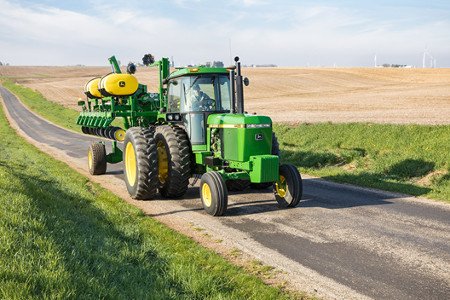
Navigate narrow roads, bridges, and field entrances with the narrow transport position of the 1745 Planter. - Planter follows the standard duals on a tractor
- Typical transport width of 3.71 m (12 ft, 2 in.)*
- Typical transport height of 3.84 m (12 ft, 7 in.)*
- Main hydraulic cylinder mast can be lowered under 3.68 m (12 ft) for storage
- Row-units fold toward the center of the road for stability
- Comparable non-folding 1785 Planter has a typical transport width of 6.96 m (22 ft, 10 in.).
|
Save time by folding the planter from the cab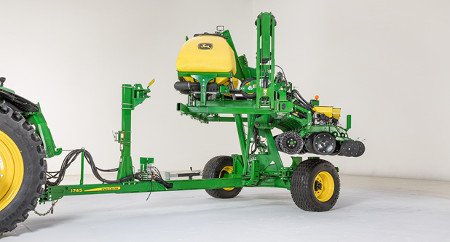
Minimize non-productive planting time by folding the planter from the cab of the tractor. - Complete the unfold and fold cycles in less than one minute.
- By utilizing a frame control box, the base planter requires one selective control valve (SCV). Folding, raise/lower, and markers can all be tied to one hydraulic circuit.
|
Increase versatility by applying liquid or dry fertilizer with a split-row planter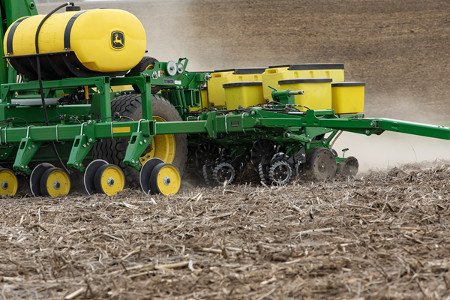
If you are looking to split-apply your fertilizer, the 1745 Planter offers liquid or dry fertilizer options on all non-bulk fill models, including split-row configurations. - Liquid fertilizer with single-disk, frame-mounted offset openers or in-furrow placement is available with a storage capacity of 1,136 L (300 gal).
- Dry fertilizer with single-disk, frame-mounted offset openers is available with a storage capacity of 1,200 L (42.4 cu ft).
- Fertilizer application is on the front rank only, with 76.2-cm (30-in.) spacing.
- The fertilizer system is driven by a tire contact drive.
|
Maximize productivity with two planter configurations to match your operation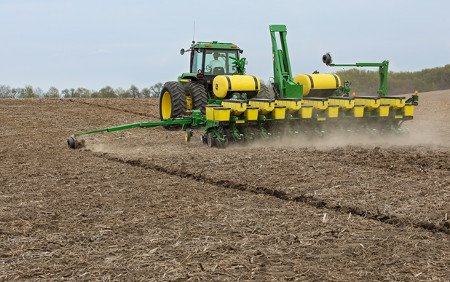
The 1745 Planter comes in two main row-unit configurations with the option of keeping it simple or adding more advanced features. - 8-row, 76.2-cm (30-in.) configuration
- 15-row, 38.1-cm (15-in.) configuration allows for planting corn in 76.2-cm (30-in.) rows and soybeans in 38.1-cm (15-in.) rows
- Select between mechanical or vacuum meters.
- Dry or liquid fertilizer is available on all non-Central Commodity System (CCS™) models.
- Select more advanced options like the Pro-Shaft™ cable drive system, RowCommand™ row clutches, CCS, and the SeedStar™ XP monitoring system.
|
Compatibility with a wide range of tractors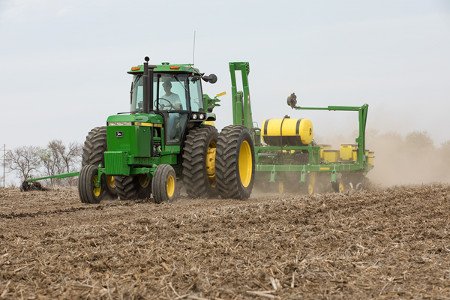
The simple design of the 1745 Planter makes it compatible with a wide range of tractors. - Non-vacuum machine requires one selective control valve (SCV) when markers are tied to lift.
- Vacuum machine requires two SCVs when markers are tied to lift.
- There is a minimum drawbar horsepower requirement of 86.5 kW (116 hp) on a 15-row machine.
- There is a minimum drawbar horsepower requirement of 70.8 kW (95 hp) on an 8-row machine.
|
Field-proven and customizable MaxEmerge™ 5 row-unit
Introduced on model year 2015 planters, the MaxEmerge 5 row-unit is proven in the field. Using the same row-unit as ExactEmerge™ planters (less meter and BrushBelt™ delivery system), it was designed to withstand the stresses associated with high-speed operation. With an open side panel design, crop changeover on vacuum meters can be accomplished without removing the hopper from the row. The row-unit also provides you the versatility to match options to your operation. - Choose finger pickup, radial bean, or vacuum meters
- Choose mini hoppers, 56-L (1.6-bu) hoppers, or 106-L (3.0-bu) hoppers
- Heavy-duty spring or pneumatic downforce
- Apply granular chemical with the insecticide option
- Variety of row cleaner and coulter options
- Spoked or smooth-sided gauge wheels
- Rubber or cast closing wheels
|
Maintain planting depth with choice of three downforce options
OVERVIEW
Planter row-unit downforce is an important factor to ensure consistent and proper depth control. With too little downforce, planter gauge wheels can lose ground contact and seeds will be planted at a shallow depth. This can result in uneven emergence, which studies have shown can impact yield 5 to 9 percent1. With too much downforce, furrow sidewalls can become smeared and compacted. Compacted sidewalls can result in hatchet roots, where plant roots grow parallel with the furrow but do not branch out between the rows.
Depending on the level of control the producer is looking for, the 1745 Planter offers three levels of downforce.
BENEFITS - Adjustable heavy-duty downforce springs provide four settings to match downforce requirements to field conditions: 0 kg (0 lb), 56.7 kg (125 lb), 113.4 kg (250 lb), and 181.4 kg (400 lb). Downforce is manually adjustable row-by-row.
- Manual control of pneumatic downforce provides simple adjustment of the whole planter from the electric compressor mounted on the front mast of the planter. The amount of downforce applied is infinitely adjustable from 6.8 to 181.4 kg (15 to 400 lb). Pneumatic downforce provides more consistent downforce throughout the range of row-unit travel compared to heavy duty downforce springs.
- Integrated control of pneumatic downforce provides simple adjustment of the whole planter conveniently from the tractor cab with the SeedStar™ XP monitoring system. Operators can see gauge wheel margin readings on three rows of the planter and either add or remove air from the pneumatic system to maintain a good level of load (margin) on the gauge wheels. The amount of downforce is infinitely adjustable from 6.8 to 181.4 kg (15 to 400 lb).
ADJUSTABLE HEAVY-DUTY DOWNFORCE SPRINGS - Four downforce settings are manually adjusted for each row-unit.
- Rows behind tires can be set on a heavier setting.
- Downforce adjustments will take more time compared to pneumatic downforce systems.
PNEUMATIC DOWNFORCE SYSTEM - MANUAL - Fill all the pneumatic air bags from one location on the planter.
- It includes simple on/off operation.
- The system has a valve stem which allows filling with shop air for faster fill times or for use as a backup if the compressor stops working.
- Split rows are plumbed on a separate circuit. This allows the air to be released only on the split rows when they need to be locked up for planting on 76.1-cm (30-in.) spacing. Set-point pressure is controlled for all rows when all rows are planting.
PNEUMATIC DOWNFORCE SYSTEM – INTEGRATED - Integrated downforce comes with an electric compressor and storage tank mounted on the rear of the planter for quick downforce adjustments.
- Downforce is easily adjusted from the display.
- The system has a valve stem which allows filling with shop air as a backup if the compressor stops working.
- The SeedStar XP monitor provides the operator downforce margin readings for the three rows equipped with a gauge wheel load sensor. Margin is essentially a reading of how much weight the gauge wheels are carrying. A positive margin ensures the planter is reaching correct planting depth. A target margin can be set to ensure proper firming of furrow sidewalls. Operators can add or remove air from the downforce system to meet the target margin.
- The SeedStar XP monitor provides the operator row-unit ride quality readings for the three rows equipped with the sensor node. Travel speed and field conditions can affect the amount of row-unit bounce that is experienced. Excessive row-unit bounce or vertical motion can cause problems with meter performance and spacing performance. The operator can slow down or increase downforce pressure to help the ride quality metric.
- Split rows are plumbed on a separate circuit. This allows the air to be released only on the split rows when they need to be locked up for planting on 76.1-cm (30-in.) spacing. Set-point pressure is controlled for all rows when all rows are planting.
|
View planter performance with choice of three monitoring systems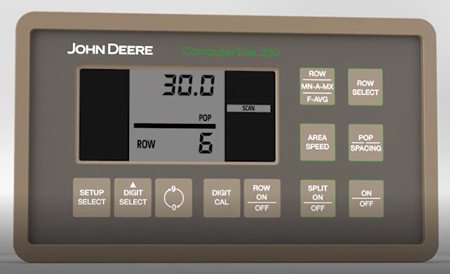
Your yield potential is never greater than when you take the seed out of the bag and put it in the ground. A lot can happen between the bag and the furrow, and that’s why John Deere offers three levels of planter monitoring systems, so you can choose what information you want to see in the cab. - ComputerTrak 350 offers a base monitor that scans the rows to monitor population and spacing (available only on the 8Row30 and 15Row15 models).
- SeedStar™ 2 provides a population monitoring bar graph to compare rows across the planter. It can also control the optional row shut-offs.
- SeedStar XP shows you population, seed singulation, seed spacing, downforce information, and ride quality. In addition, you can adjust the optional pneumatic down pressure and the optional row shut-offs from the display.
|
Plant more ground between fills with the Central Commodity System (CCS™)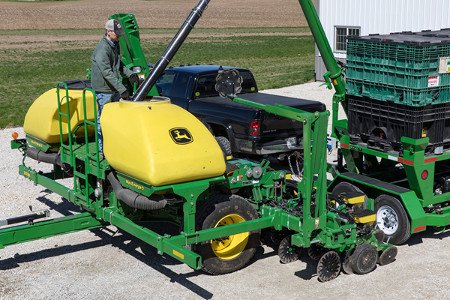
The CCS adds productivity through increased seed capacity, bulk fill capability, and easy, thorough cleanout. - The two tanks have a combined capacity of 1,762 L (50 bu) which is 176 L (5 bu) more than a 15-row planter with 106-L (3-bu) hoppers.
- Translucent tanks allow the operator to see the seed level, and bin-level sensors alert the operator when the seed level is low.
- Filling the tanks is convenient due to a central filling location. The staircase and railing provide access to the filling platform between the tanks.
- Two platform lights improve visibility if filling at night.
- The following crops can be planted with CCS: corn, sweet corn, popcorn, cotton, sunflowers, sugar beets, soybeans, and sorghum (milo).
Cleanout is easy since a pro-box can fit under the CCS tanks when the planter is in the lifted position. |
John Deere Connected Support™ prevents downtime and efficiently resolves issues with revolutionary technology-based solutions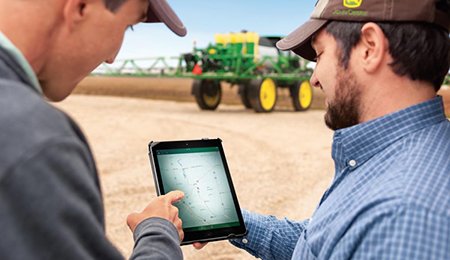
When you buy John Deere equipment, you expect reliability. You also know that problems can happen, and a product is only as good as the support behind it. That’s why John Deere equipment is prepared with technology that senses potential issues and can alert you and your dealer promptly—in the cab or anywhere you are.
John Deere Connected Support is a revolutionary change to support that leverages technology and the connectivity of JDLink™ telematics to prevent downtime and resolve problems faster. These tools decrease downtime by an average of 20 percent, enabling faster responses to unexpected problems and reducing technician trips to your machine. For some issues, unplanned downtime can even be prevented altogether through prediction of the issue.
With your permission, John Deere Connected Support: - Keeps you running by monitoring machine health and promptly alerting you and your dealer of issues
- Saves time by remotely viewing in-cab displays, reducing trips to the machine
- Reduces or even eliminates technician trips to a machine through remote diagnostic and remote software reprogramming capabilities
- Connects experts with the information needed to respond to downtime faster and prevent it altogether
With more than a decade of experience leveraging connectivity to solve problems, no one else has the experience, tools, and knowledge to keep you running as John Deere and your John Deere dealer can. Connected Support is an in-base feature on all John Deere products with factory- or field-installed JDLink. |
Advantages of an even-rowed planter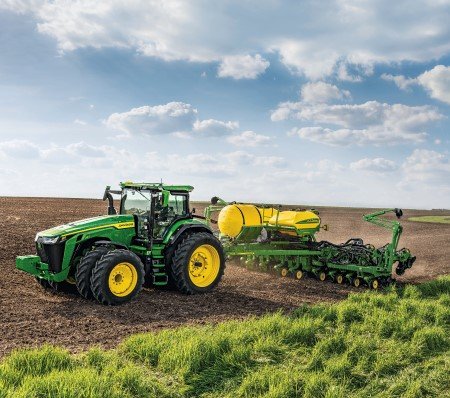
Even-row planter configurations are designed to plant no-till soybeans between standing corn stalks. The extra row, along with a two-position hitch, makes it possible to place two soybean rows between the old corn rows, and the guess rows match up across the field. This gives better depth consistency since gauge wheels aren’t running on top of standing corn stalks. - Increase productivity by 7 percent when planting with all rows.
- Effective working width is the same when planting corn or soybeans.
- By shifting the hitch of the tractor, producers can split last year’s corn rows with two soybean rows while keeping the tractor’s tires between the corn rows.
- Guess rows match up when planting parallel with last year’s rows.
The extra row-unit is placed at the left side of the planter on the rear rank of row units. It does not increase road transportation width or height.
When planting on 38.1-cm (15-in.) spacing, the working width is increased by 38.1-cm (15-in.), or 3 to 4 percent. To change over to 38.1-cm (15-in.) planting on an even-rowed planter, the two-point hitch needs to be offset. While planting on 76.2-cm (30-in.) spacing, the attaching bolt is in the center position. When changing to 38.1-cm (15-in.) spacing, the planter is offset 19-cm (7.5-in.) to the side. The markers would need to be adjusted.
The offset hitch puts a slightly higher draft load on the right side of the tractor than the left side. For wheeled tractor applications, the operator is actively steering the tractor and a different draft load isn’t obvious nor is the steering cumbersome. On track tractors, where the steering wheel returns to a neutral position, it is obvious that the draft of the planter isn’t centered behind the tractor. |














